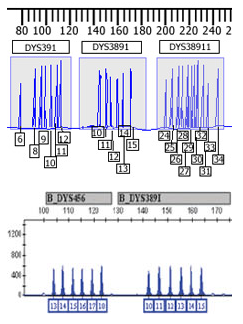Archival Notice
This is an archive page that is no longer being updated. It may contain outdated information and links may no longer function as originally intended.
Home | Glossary | Resources | Help | Contact Us | Course Map
In the United States, the development of Y-STR core loci has followed a pattern similar to the development of the CODIS core STR loci. The Scientific Working Group for DNA Analysis Methods (SWGDAM) created a subcommittee to investigate Y-STRs. The subcommittee reviewed published data and ran several hundred population database samples to evaluate various loci.
The subcommittee established the following 11 loci as the core Y-STR loci:
- DYS19
- DYS385 A/B
- DYS389I
- DYS389II
- DYS390
- DYS391
- DYS392
- DYS393
- DYS438
- DYS439
- DYS1908
With the establishment of the core loci, manufacturers have the specifications needed for the development of Y-STR kits
European laboratories have also established core Y-STR loci for forensic testing. ENFSI decided to use the same loci as the United States, minus DYS438 and DYS439.09
Additional Online Courses
- What Every First Responding Officer Should Know About DNA Evidence
- Collecting DNA Evidence at Property Crime Scenes
- DNA – A Prosecutor’s Practice Notebook
- Crime Scene and DNA Basics
- Laboratory Safety Programs
- DNA Amplification
- Population Genetics and Statistics
- Non-STR DNA Markers: SNPs, Y-STRs, LCN and mtDNA
- Firearms Examiner Training
- Forensic DNA Education for Law Enforcement Decisionmakers
- What Every Investigator and Evidence Technician Should Know About DNA Evidence
- Principles of Forensic DNA for Officers of the Court
- Law 101: Legal Guide for the Forensic Expert
- Laboratory Orientation and Testing of Body Fluids and Tissues
- DNA Extraction and Quantitation
- STR Data Analysis and Interpretation
- Communication Skills, Report Writing, and Courtroom Testimony
- Español for Law Enforcement
- Amplified DNA Product Separation for Forensic Analysts


